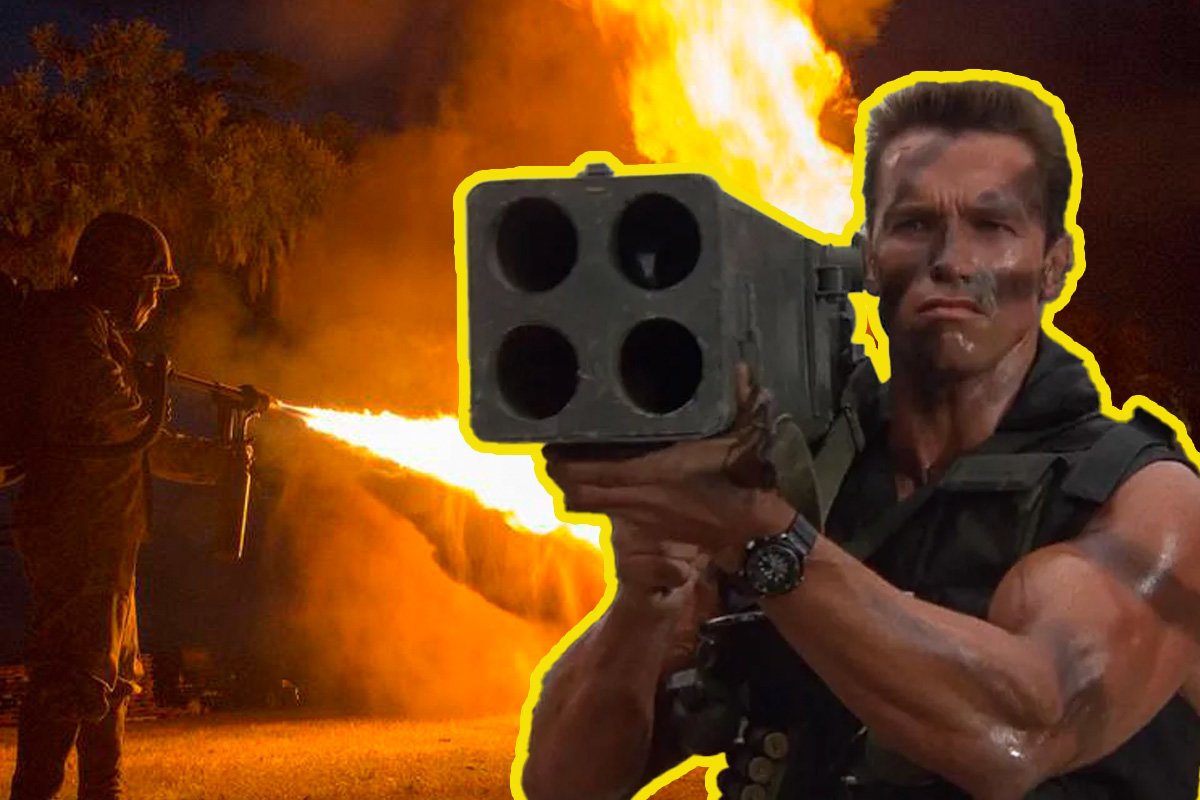Why the ‘Commando’ Quad-Tube Rocket Launcher Replaced the Flamethrower

The quad-tubed rocket launcher from the 1985 action classic Commando was actually tested by the US Army to replace the flamethrower. Photo by Lance Cpl. Shane T. Manson. Composite by Coffee or Die Magazine.
Arnold Schwarzenegger’s 1985 action classic Commando cemented the former Mr. Olympia as a bona fide action hero. The entire movie is full of glorious ’80s cheese, but it’s the infamous “mansion shootout” that lives rent-free in the minds of most Gen Xers. In it, John Matrix (Schwarzenegger) uses a four-tubed, shoulder-fired rocket launcher against scores of enemy soldiers.
Matrix sends his first rocket careening into a jeep full of hip-firing bad guys, then wastes no time blasting a second rocket into a gate — creating a Predator-sized hole for a hasty escape. As made clear in the movie, the M202 and M202A1 Flame Assault Shoulder Weapons (FLASHs) aren’t your average rocket launchers. In fact, the iconic weapon was actually created to replace flamethrowers.
In the 1960s, the US Army attempted to improve on the old M1 and M2 flamethrowers from World War II. The goal was to increase the effective range of incendiary weapons and increase safety for the operators. The old portable flamethrowers required users to be dangerously close to the enemy, and the large, cumbersome tanks carried on flamethrower troops’ backs left them vulnerable and exposed to enemy fire.
Despite an earlier request by the US Marine Corps for an updated weapon system, the plans to replace the flamethrower did not go into motion until the US Army’s 9th Infantry Division asked for a weapon capable of neutralizing enemy bunkers from great standoff ranges. Their answer came in the form of an incendiary rocket launcher.
“Capable of firing four incendiary rockets in four seconds, the weapon can be used to attack bunkers, automatic weapons positions, and materiel,” a narrator says in a demonstration video. “Its 200-yard range for point targets is more than triple that of the flamethrower, and it can be used against area targets up to 700 yards away.”
According to a report from 1970, the weapon was first called the XM191 Multishot Portable Flame Weapon. Each M74 incendiary rocket contained a chemical mixture of thickened triethylaluminum: a compound that differed from napalm and ensured a continuation of burning material when exposed to oxygen. When a rocket was fired from the launcher, a small explosive charge inside the warhead armed and detonated, sending the flammable material roughly 60 feet in every direction.
“The weapon reflects a radical departure from traditional flame throwers,” Army Lt. Gen. Frank Mildren said in 1970 during an official debriefing, according to The National Interest. “It relieves the field soldier from the burden of mixing flame fuels for the weapons.”
However, most of the launchers, including the US Army’s final design — the M202A1 FLASH — were left in US military purgatory following the Pentagon’s 1978 decision to remove flame weapons from future battlefields.
Read Next:

Matt Fratus is a history staff writer for Coffee or Die. He prides himself on uncovering the most fascinating tales of history by sharing them through any means of engaging storytelling. He writes for his micro-blog @LateNightHistory on Instagram, where he shares the story behind the image. He is also the host of the Late Night History podcast. When not writing about history, Matt enjoys volunteering for One More Wave and rooting for Boston sports teams.
BRCC and Bad Moon Print Press team up for an exclusive, limited-edition T-shirt design!
BRCC partners with Team Room Design for an exclusive T-shirt release!
Thirty Seconds Out has partnered with BRCC for an exclusive shirt design invoking the God of Winter.
Lucas O'Hara of Grizzly Forge has teamed up with BRCC for a badass, exclusive Shirt Club T-shirt design featuring his most popular knife and tiomahawk.
Coffee or Die sits down with one of the graphic designers behind Black Rifle Coffee's signature look and vibe.
Biden will award the Medal of Honor to a Vietnam War Army helicopter pilot who risked his life to save a reconnaissance team from almost certain death.
Ever wonder how much Jack Mandaville would f*ck sh*t up if he went back in time? The American Revolution didn't even see him coming.
A nearly 200-year-old West Point time capsule that at first appeared to yield little more than dust contains hidden treasure, the US Military Academy said.












